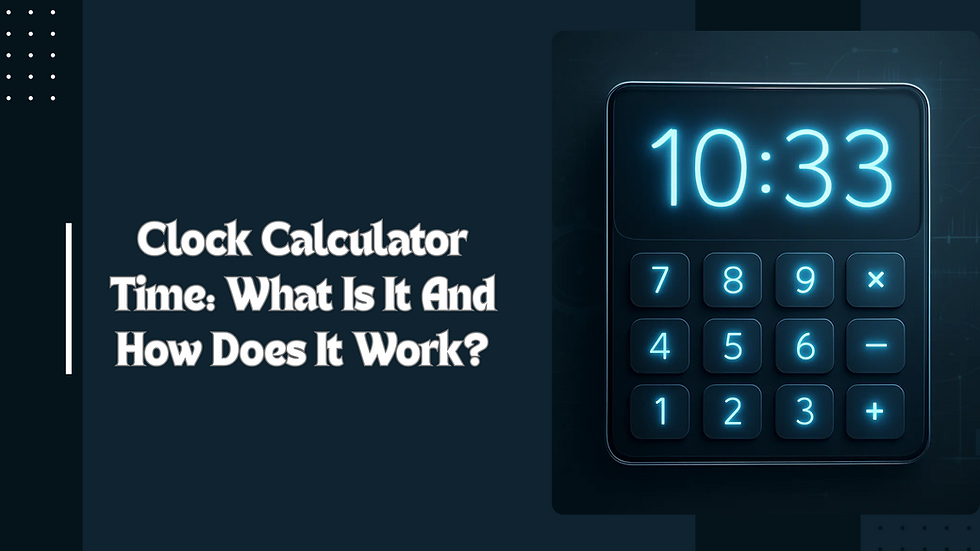Clock Calculator Time: What Is It And How Does It Work?
- silvalea884
- Aug 7
- 3 min read

Have you ever struggled with tracking hours worked, calculating overtime, or converting clock-in and clock-out times? You're not alone. In a world where time equals productivity, having a simple yet accurate solution matters. That's where the concept of "clock calculator time" comes in. But what exactly does it mean, and how does it work in day-to-day operations?
Let's break it down.
What Is Clock Calculator Time?
Clock calculator time refers to digital tools designed to compute the total number of hours worked based on clock-in and clock-out inputs. Whether you're an HR manager, a small business owner, or a freelancer, these calculators simplify payroll, enhance accuracy, and reduce manual time-tracking errors.
These tools can:
Automatically subtract break times
Convert 12-hour or 24-hour formats into total hours
Handle overnight shifts
Provide summaries of hours worked daily, weekly, or monthly
How Does A Clock Calculator Work?
A typical clock calculator asks you to input the start time and end time of a work shift. It then calculates the difference and may allow customization for unpaid breaks, rounding rules, or overtime policies. Some calculators also support exporting data into time sheets or payroll software.
For example:
Start Time: 9:00 AM
End Time: 5:30 PM
Unpaid Break: 30 minutes
Total Hours Worked: 8.0 hours
In this context, the time card calculator plays a critical role in generating accurate records without needing to perform manual math.
Why Use A Clock Calculator?
Clock calculators eliminate guesswork and prevent disputes about logged hours. Here are a few reasons businesses and individuals turn to these tools:
Time-saving: Automation speeds up payroll and reduces admin work
Accuracy: Reduces human errors and miscalculations
Transparency: Offers clear visibility into employee work hours
Compliance: Helps businesses meet labor law requirements
Integrating with Modern Tools: The Role of Geofence Time Clock
As time tracking evolves, many companies now integrate a geofence time clock with their clock calculators. This system uses GPS to ensure employees are within a defined area before allowing them to clock in or out. It’s particularly beneficial for remote teams, delivery services, and field workers.
Pairing geofencing with a clock calculator ensures:
Increased accountability
Location-based automation
Elimination of buddy punching
This combination not only improves accuracy but also ensures employees are paid for legitimate hours on site.
How To Manage Time Effectively With Clock Calculators
Time management isn't just about tracking hours — it’s about using the data to drive productivity. So, how to manage time effectively using clock calculator insights?
Here’s how:
Set clear work expectations – Use historical data to predict workloads
Identify bottlenecks – Spot recurring overtime or late logins
Reward productivity – Recognize employees who manage time efficiently
Optimize schedules – Use data to align shifts with peak performance times
When businesses make informed decisions based on actual time logs, productivity and morale both increase.
Advanced Features In Clock Calculators
Modern clock calculators often include features such as:
Mobile compatibility
Multi-user access
Cloud backup
Integration with payroll or project management software
Some tools even incorporate AI to suggest optimal break times, shift rotations, or highlight inefficiencies.
Time Card Calculator In the Bigger Picture
While clock calculators handle basic time math, the time card calculator adds layers of payroll-specific functionality. It accommodates:
Overtime thresholds
Paid/unpaid leave tracking
Holiday hour considerations
Together, these tools form the backbone of a reliable workforce management strategy.
You can also watch this video: Emp Monitor | Boost Workplace Productivity with Employee Monitoring Software
Summary
Clock calculator time is more than a digital tool — it's a productivity solution. It helps businesses calculate hours worked, reduce errors, and ensure compliance, all while enhancing employee trust. With integrations like geofence time clocks and insights into how to manage time more efficiently, these calculators can transform time tracking from a chore into a strategic asset.
FAQs
Q1: What’s the main purpose of a clock calculator?To calculate total work hours based on clock-in and clock-out times quickly and accurately.
Q2: Can I use a clock calculator for remote teams?Yes, especially when integrated with a geofence time clock or mobile app.
Q3: What’s the difference between a clock calculator and a time card calculator?A clock calculator computes basic hours, while a time card calculator handles payroll-related functions like overtime and leave.
Q4: Is it possible to automate payroll with these tools?Absolutely. Most advanced tools integrate with payroll systems for seamless data transfer.
Q5: Are clock calculators secure?
Most reputable tools offer encryption and cloud backup to protect sensitive data.





Comments